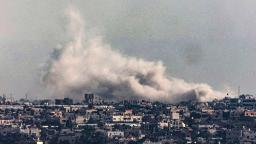
Some buildings were flattened or partially collapsed. Others are exposed to bullet holes or smoke marks. Civilians are nowhere to be found.
This is the scene that CNN found on the outskirts of Bureij in the central Gaza Strip after three months of war.
CNN accompanied the Israeli military on Monday, to get a glimpse of the devastation inside Gaza and a rare look at Hamas’s alleged underground infrastructure and weapons manufacturing uncovered by Israeli forces.
Next to bulldozed farmland and inside an ordinary building, the Israeli army took journalists inside the opening of what it said was a tunnel system leading to an above-ground and underground weapons manufacturing facility.
An officer identified as Major Ariel from the 188th Brigade, who revealed the entrance to the tunnel, said: “We are standing at one of the main entrances to the terrorist manufacturing center.”
Under a nearby shed, the Israeli army showed another opening leading to the same tunnel.
The Israeli military also showed reporters the above-ground manufacturing facility, where CNN saw mortar shells that Israeli leaders said were made there. There is another tunnel shaft in the corner of the factory, leading to what the Israeli military said was an underground facility where explosive materials — made in some cases from dual-use materials such as fertilizer — are packed into shells.
The Israeli army did not allow journalists to go underground, saying that the chemicals made it too dangerous, but it provided a video that it said was filmed inside that underground facility where large vats and industrial materials could be seen.
“What we are seeing is the use of consolidated civilian industries to build the missile industry,” Daniel Hagari, an IDF spokesman, told CNN inside the weapons facility, a point he repeatedly raised throughout the day.
When asked if he was emphasizing the connection between Hamas’ infrastructure and civilian buildings to justify the high number of civilian deaths in Gaza, Hajari said: “We’re focusing on Hamas, not, no — we’re focusing on the war on Hamas, we’re focusing on the war on Hamas, “We are focusing on Hamas.” No to fighting the people of Gaza.”
“Every death of every child is a tragedy. We did not want this war,” Hajjari said.
Low intensity phase: Israel expanded its ground offensive into central Gaza in late December, and over the past two weeks it has carried out raids and pushed its ground forces into areas it had previously urged civilians to evacuate.
But there are indications that it is slowing down its attack in parts of Gaza, and moving to a less intense phase of the war after significant American pressure.
“There’s a big change because it’s a different level of intensity. Now, it’s not with the same intensity and high intensity that we worked at in northern (Gaza),” Hajjari said. “It’s more of a sustained effort at the center of gravity so we can make sure to differentiate between residents and terrorists.” He added: “And the focus is on Hamas’ frameworks.”


